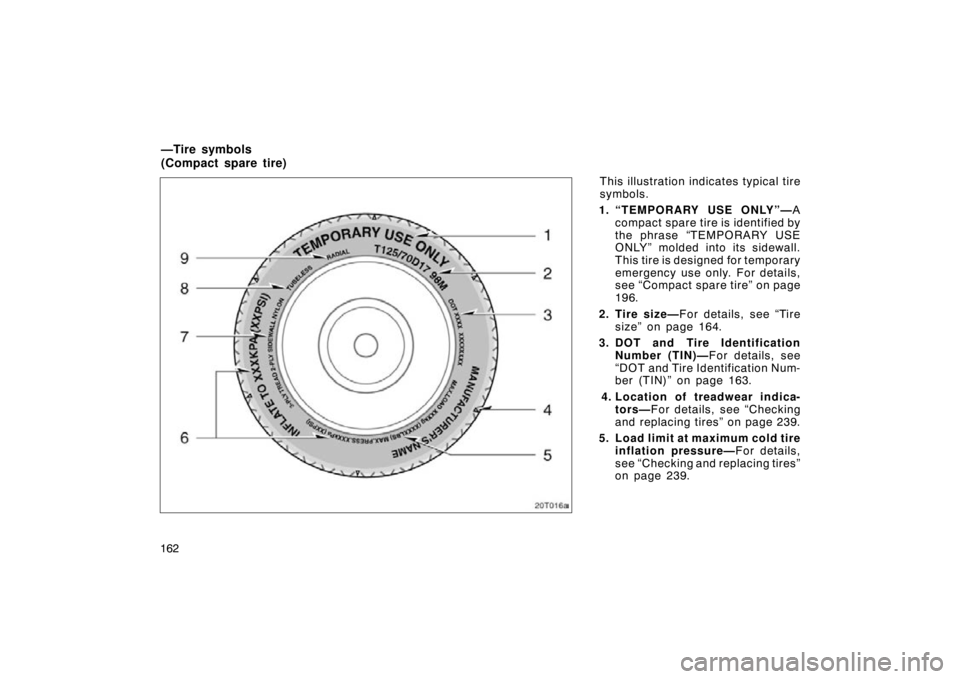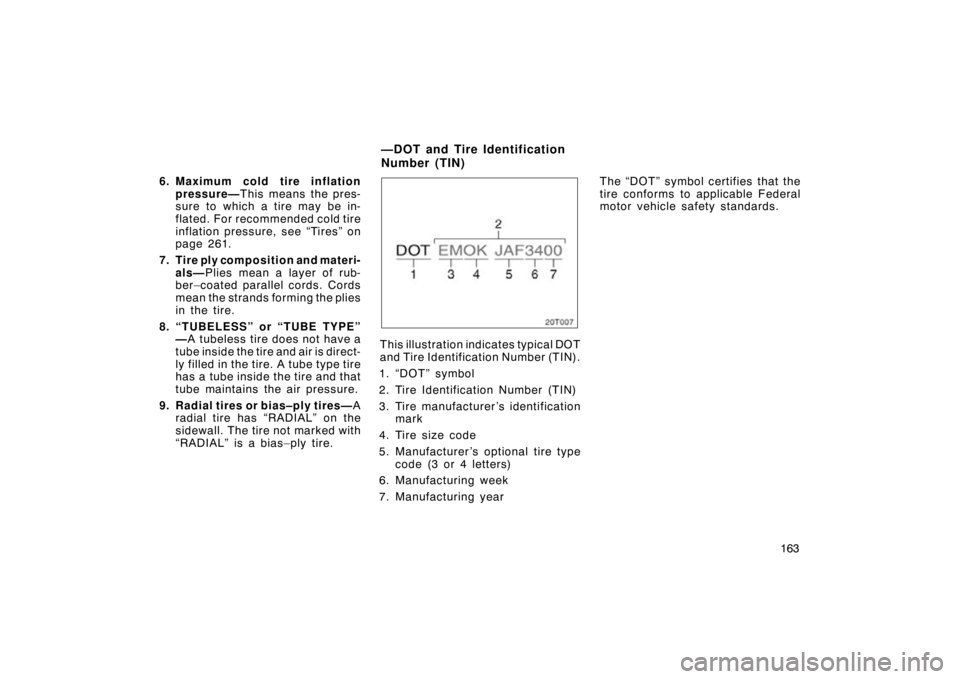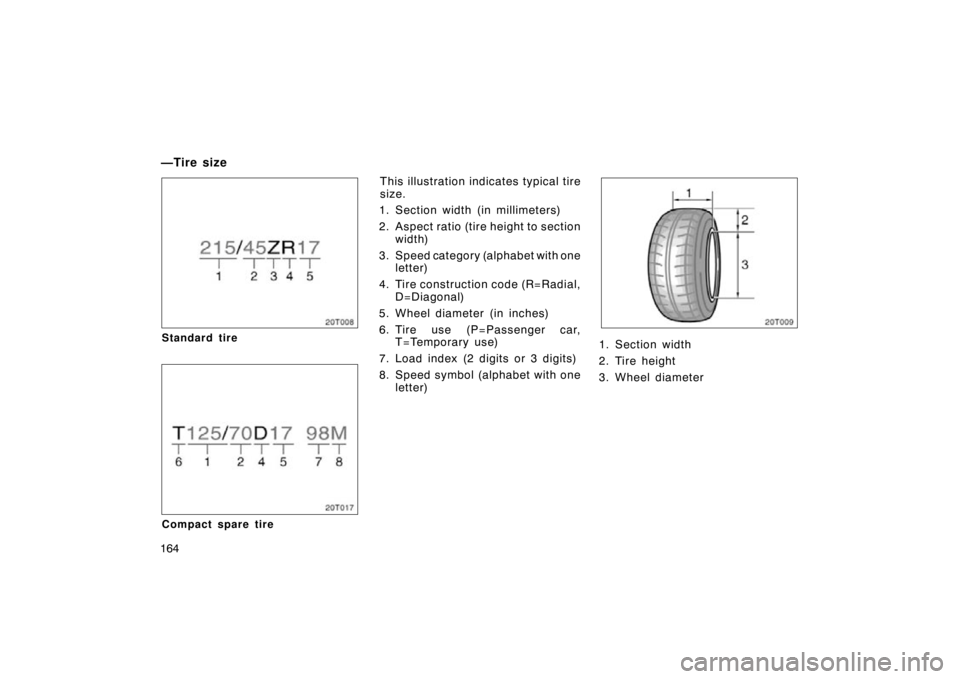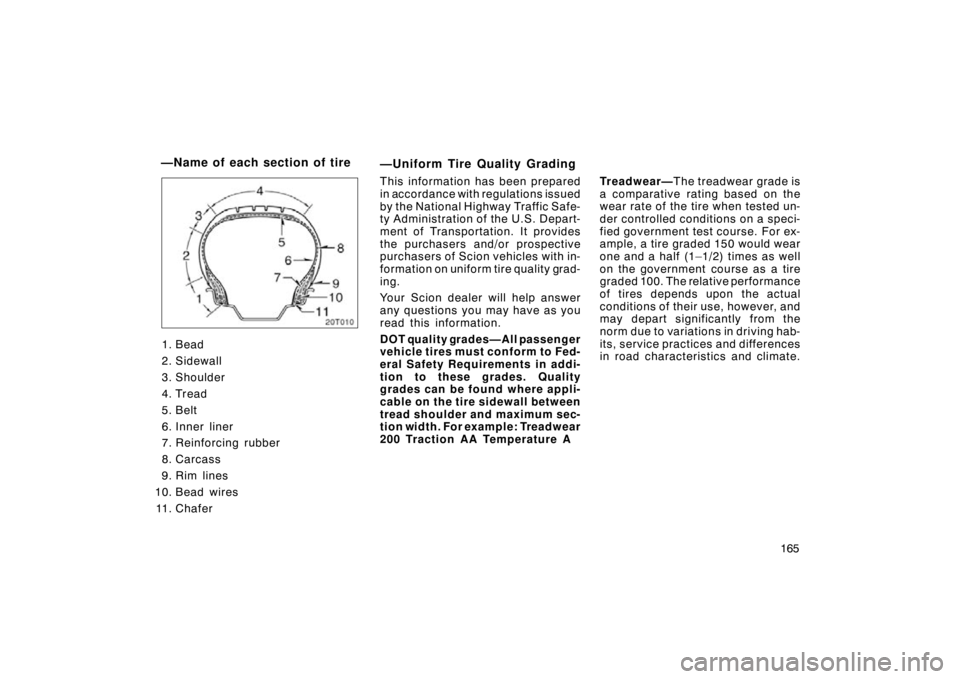TOYOTA tC 2009 Owners Manual (in English)
Manufacturer: TOYOTA, Model Year: 2009, Model line: tC, Model: TOYOTA tC 2009Pages: 287, PDF Size: 3.25 MB
Page 171 of 287

161
7. “TUBELESS” or “TUBE TYPE”
—Tubeless tire does not have a
tube inside the tire and air is direct-
ly filled in the tire, avoiding rapid
air leakage even if the tire is nailed
and preventing the tire from burst-
ing with a shock. Tube type tire has
a tube inside the tire and that tube
maintains the air pressure.
8. Load limit at maximum cold tire inflation pressure— For details,
see “Checking and replacing tires”
on page 239.
9. Maximum cold tire inflation pressure— This means the pres-
sure to which a tire may be in-
flated. For recommended cold tire
inflation pressure, see “Tires” on
page 261.
10. Uniform tire quality grading— For details, see “Uniform tire quali-
ty grading” that follows.
Page 172 of 287

162This illustration indicates typical tire
symbols.
1. “TEMPORARY USE ONLY”— A
compact spare tire is identified by
the phrase “TEMPORARY USE
ONLY” molded into its sidewall.
This tire is designed for temporary
emergency use only. For details,
see “Compact spare tire” on page
196.
2. Tire size— For details, see “Tire
size” on page 164.
3. DOT and Tire Identification Number (TIN)— For details, see
“DOT and Tire Identification Num-
ber (TIN)” on page 163.
4. Location of treadwear indica- tors— For details, see “Checking
and replacing tires” on page 239.
5. Load limit at maximum cold tire inflation pressure— For details,
see “Checking and replacing tires”
on page 239.
—Tire symbols
(Compact spare tire)
20T016a
Page 173 of 287

163
6. Maximum cold tire inflation
pressure— This means the pres-
sure to which a tire may be in-
flated. For recommended cold tire
inflation pressure, see “Tires” on
page 261.
7. Tire ply composition and materi- als— Plies mean a layer of rub-
ber–coated parallel cords. Cords
mean the strands forming the plies
in the tire.
8. “TUBELESS” or “TUBE TYPE” —A tubeless tire does not have a
tube inside the tire and air is direct-
ly filled in the tire. A tube type tire
has a tube inside the tire and that
tube maintains the air pressure.
9. Radial tires or bias–ply tires— A
radial tire has “RADIAL” on the
sidewall. The tire not marked with
“RADIAL” is a bias–ply tire.
20T007
This illustration indicates typical DOT
and Tire Identification Number (TIN).
1. “DOT” symbol
2. Tire Identification Number (TIN)
3. Tire manufacturer ’s identification mark
4. Tire size code
5. Manufacturer ’s optional tire type code (3 or 4 letters)
6. Manufacturing week
7. Manufacturing year The “DOT” symbol certifies that the
tire conforms to applicable Federal
motor vehicle safety standards.
—DOT and Tire Identification
Number (TIN)
Page 174 of 287

164
20T008
Standard tire
20T017
Compact spare tire
This illustration indicates typical tire
size.
1. Section width (in millimeters)
2. Aspect ratio (tire height to section width)
3. Speed category (alphabet with one letter)
4. Tire construction code (R=Radial, D=Diagonal)
5. Wheel diameter (in inches)
6. Tire use (P=Passenger car, T=Temporary use)
7. Load index (2 digits or 3 digits)
8. Speed symbol (alphabet with one letter)
20T009
1. Section width
2. Tire height
3. Wheel diameter
—Tire size
Page 175 of 287

165
20T010
1. Bead
2. Sidewall
3. Shoulder
4. Tread
5. Belt
6. Inner liner
7. Reinforcing rubber
8. Carcass
9. Rim lines
10. Bead wires 11. Chafer
—Uniform Tire Quality Grading
This information has been prepared
in accordance with regulations issued
by the National Highway Traffic Safe-
ty Administration of the U.S. Depart-
ment of Transportation. It provides
the purchasers and/or prospective
purchasers of Scion vehicles with in-
formation on uniform tire quality grad-
ing.
Your Scion dealer will help answer
any questions you may have as you
read this information.
DOT quality grades—All passenger
vehicle tires must conform to Fed-
eral Safety Requirements in addi-
tion to these grades. Quality
grades can be found where appli-
cable on the tire sidewall between
tread shoulder and maximum sec-
tion width. For example: Treadwear
200 Traction AA Temperature A Treadwear—
The treadwear grade is
a comparative rating based on the
wear rate of the tire when tested un-
der controlled conditions on a speci-
fied government test course. For ex-
ample, a tire graded 150 would wear
one and a half (1–1/2) times as well
on the government course as a tire
graded 100. The relative performance
of tires depends upon the actual
conditions of their use, however, and
may depart significantly from the
norm due to variations in driving hab-
its, service practices and differences
in road characteristics and climate.
—Name of each section of tire
Page 176 of 287

166 Traction AA, A, B, C—The traction
grades, from highest to lowest, are
AA, A, B, and C, and they represent
the tire’s ability to stop on wet pave-
ment as measured under controlled
conditions on specified government
test surfaces of asphalt and concrete.
A tire marked C may have poor trac-
tion performance.
Warning: The traction grade assigned
to this tire is based on braking
(straight ahead) traction tests and
does not include cornering (turning)
traction. Temperature A, B, C—
T he tem per a-
ture grades are A (the highest), B,
and C, representing the tire’s resis-
tance to the generation of heat and
its ability to dissipate heat when
tested under controlled conditions on
a specified indoor laboratory test
wheel. Sustained high temperature
can cause the material of the tire to
degenerate and reduce tire life, and
excessive temperature can lead to
sudden tire failure. The grade C cor-
responds to a level of performance
which all passenger car tires must
meet under the Federal Motor Vehicle
Safety Standard No. 109. Grades B
and A represent higher levels of per-
formance on the laboratory test wheel
than the minimum required by law.
Warning: The temperature grades for
this tire are established for a tire that
is properly inflated and not over-
loaded. Excessive speed, underinfla-
tion, or excessive loading, either sep-
arately or in combination, can cause
heat buildup and possible tire failure.
Page 177 of 287

167
Ti r e relat ed ter m
Meaning
Cold tire inflation pressure
tire inflation pressure when the vehicl
e has been parked for at leas t 3 hour s
or more, or it has not been driven more than 1.5 km or 1 mile under that
condition
Maximum inflation pressurethe maximum cold inflation pressure to which a tire may be inflated and it is
shown on the sidewall of the tire
Recommended inflation pressurecold tire inflation pressure recommended by a manufacturer
Accessory weight
the combined weight (in excess of those standard items which may be replaced)
of automatic transmission, power steering, power brakes, power windows, pow-
er seats, radio, and heater, to the extent that these items are available as
factory −installed equipment (whether installed or not)
Curb weight
the weight of a motor vehicle with standard equipment including the maximum
capacity of fuel, oil, and coolant, and, if so equipped, air conditioning and addi-
tional weight optional engine
Maximum loaded vehicle weight
t he sum of —
(a) curb weight;
(b) accessory weight;
(c) vehicle capacity weight; and
(d) production options weight
Normal occupant weight68 kg (150 lb.) times the number of occupants specified in the second column
of Table 1 that follows
—Glossary of tire terminology
Page 178 of 287

168Ti r e relat ed ter m
Meaning
Occupant distributiondistribution of occupants in a vehicle as specified in the third column of Table
1 that follows
Production options weight
the combined weight of those installed regular production options weighing over
2.3 kg (5 lb.) in excess of those standard items which they replace, not pre-
viously considered in curb weight or accessory weight, including heavy duty
brakes, ride levelers, roof rack, heavy duty battery, and special trim
Rima metal support for a tire or a tire and tube assembly upon which the tire beads
are seated
Rim diameter (Wheel diameter)nominal diameter of the bead seat
Rim size designationrim diameter and width
Rim type designationthe industry of manufacturer ’s designation for a rim by style or code
Rim widt hnominal distance between rim flanges
Vehicle capacity weight
(Total load capacity)the rated cargo and luggage load plus 68 kg (150 lb.) times the vehicle’s desig-
nated seating capacity
Vehicle maximum load on the tirethe load on an individual tire that is determined by distributing to each axle
its share of the maximum loaded vehicle weight and dividing by two
Vehicle normal load on the tire
the load on an individual tire that is determined by distributing to each axle
its share of the curb weight, accesso
ry weight, and normal occupant weight
(distributed in accordance with Table 1 that follows) and dividing by two
Page 179 of 287

169
Ti r e relat ed ter m
Meaning
Weather sidethe surface area of the rim no
t covered by the inflated tire
Beadthe part of the tire that is made of steel wires, wrapped or reinforced by ply
cords and that is shaped to fit the rim
Bead separationa breakdown of the bond between components in the bead
Bias ply tirea pneumatic tire in which the ply cords that extend to the beads are laid at
alternate angles substantially less than 90 degrees to the centerline of the tread
Carcassthe tire structure, except tread and sidewall rubber which, when inflated, bears
the load
Chunkingthe breaking away of pieces of the tread or sidewall
Cordthe strands forming the plies in the tire
Cord separationthe parting of cords from adjacent rubber compounds
Crackingany parting within the tread, sidewall, or innerliner of the tire extending to cord
material
CT
a pneumatic tire with an inverted flange tire and rim system in which the rim
is designed with rim flanges pointed radi ally inward and the tire is designed
to fit on the underside of the rim in a manner that encloses the rim flanges
inside the air cavity of the tire
Extra load tirea tire designed to operate at higher loads and at higher inflation pressures
than the corresponding standard tire
Page 180 of 287

170Ti r e relat ed ter m
Meaning
Groovethe space between two adjacent tread ribs
Innerlinerthe layer(s) forming the inside surface of a tubeless tire that contains the inflat-
ing medium within the tire
Innerliner separationthe parting of the innerliner from cord material in the carcass
Intended outboard sidewall
(A) the sidewall that contains a whitewall, bears white lettering or bears
manufacturer, brand, and/or model name molding that is higher or deeper
than the same molding on the other sidewall of the tire, or
(B) the outward facing sidewall of an asymmetrical tire that has a particular side that must always face outward when mounted on a vehicle
Light truck (LT) tirea tire designated by its manufacturer as primarily intended for use on lightweight
trucks or multipurpose passenger vehicles
Load ratingthe maximum load that a tire is rated to carry for a given inf lat ion pr es s ur e
Maximum load ratingthe load rating for a tire at the maximu m permissible inflation pressure for that
tire
Maximum permissible inflation pres-
surethe maximum cold inflat ion pressure to which a tire may be inflated
Measuring rimthe rim on which a tire is fitted for physical dimension requirements
Open spliceany parting at any junction of tread, sidewall, or innerliner that extends to cord
material